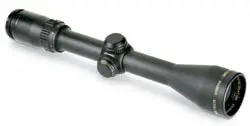|
Bushnell Ballistic Reticle Elite 3200 3-9x40mm Riflescope  The tested scope is the Bushnell Elite 3200 3-9 x 40mm, newly offered in 2006 with a ballistic reticle. This 13 oz. scope features quick-focus, fingertip metal on metal click adjustments, a one-piece hammer forged titanium-aluminum tube, and Bushnell's highly praised "RainGuard." It is the same tube and design as the standard Bushnell 3200 3-9 x 40 scope, the "winner" in the under $200 price range from two years ago. Few reviews mention any initial quality problems, but I believe that sooner or later most folks appreciate candidness. The first scope obtained for testing had a black spot on one of the elements inside the scope, visible in the upper left quadrant of the reticle. No other problems were noted (or likely), but most people would certainly send back a $275 scope that had an obvious flaw. Back to Bushnell it went, and it was replaced. However, the second scope has three black spots inside the tube, located in the lower left quadrant of the reticle. I've not had any problems with Bushnell Elites before or since. Bushnell's lifetime warranty is a good one, but I found two so very obviously flawed scopes in a row a bit disconcerting. The quality control on the "ballistic reticle" line needs a look. The Bushnell Ballistic reticle is similar to the "TDS" reticle found on the higher end Kahles scopes, and allows you to compensate for both drop and windage. The reticle is etched glass, not wire as found in most scopes this side of a Zeiss Conquest. It is considered stronger than a wire reticle, and is also more difficult and costly to produce. That partially explains both the approx. $75 up-charge for this reticle and perhaps the flaws I noticed in this specific model. To be fair, I've yet to hear of any scope maker that has never distributed a bad tube. Maybe that's why they all have customer service departments? The whole reason to buy this scope vs. a standard Elite 3200 is the reticle. Bushnell dropped the ball a bit in their instructions, which stated the lines are 3 MOA apart, equating to 3 inches at 100 yards and 15 inches of drop at 500 yards. Though the term "MOA" is roughly equated to inches in the terse instruction sheet, the range bars are indeed 3 MOA apart. For a dedicated long range unit, the T. D. Smith style reticle does have more features than the Burris Ballistic reticle. It can be used for not just drop, but windage and range-finding as well, although you wouldn't be aware of it based on the instructions as supplied. I've long lauded and appreciated the Bushnell Elite 3200 series as one of the best values in riflescopes today. The recent Bushnell 3200 3-10 x 40 'compact' scope is my personal favorite. They remain so. The RainGuard works, the tubes are strong, the scopes hold their zero, and very few folks can tell the difference between these 90-91% light transmission models and most any other scope on the market during legal hunting hours. Based on the current retail/online prices of this specific model, however, I would consider another scope. That is, unless you really appreciate the TDS reticle and plan to exploit it. In that case, there is nothing on the market that can be had for even twice the price. |